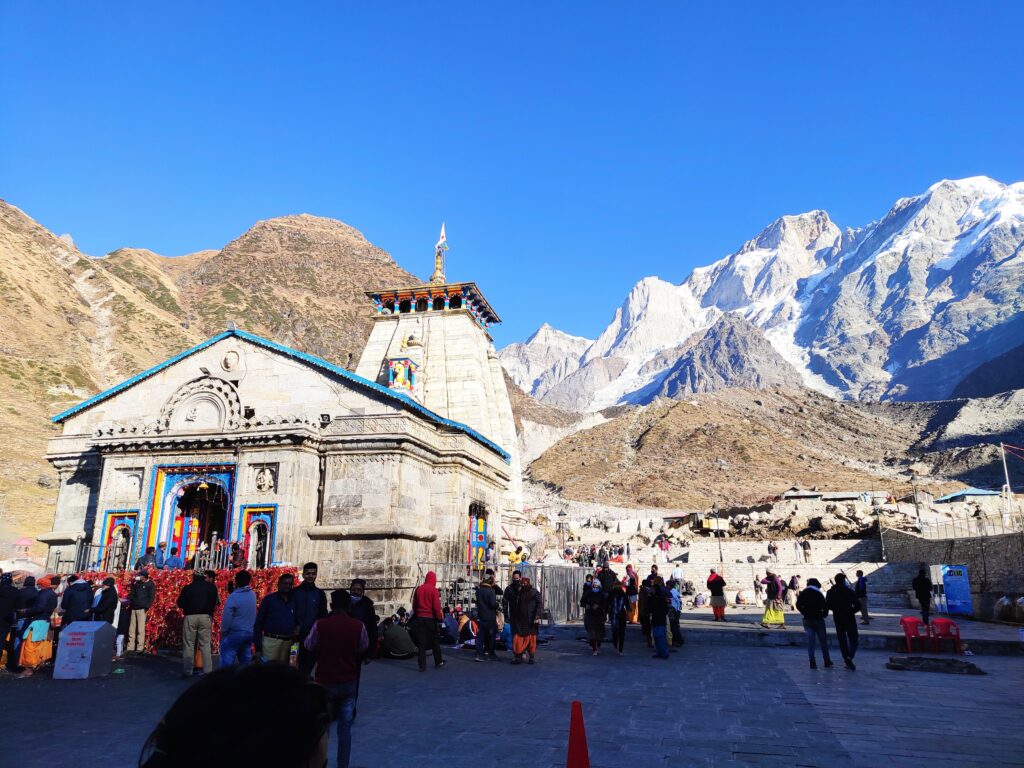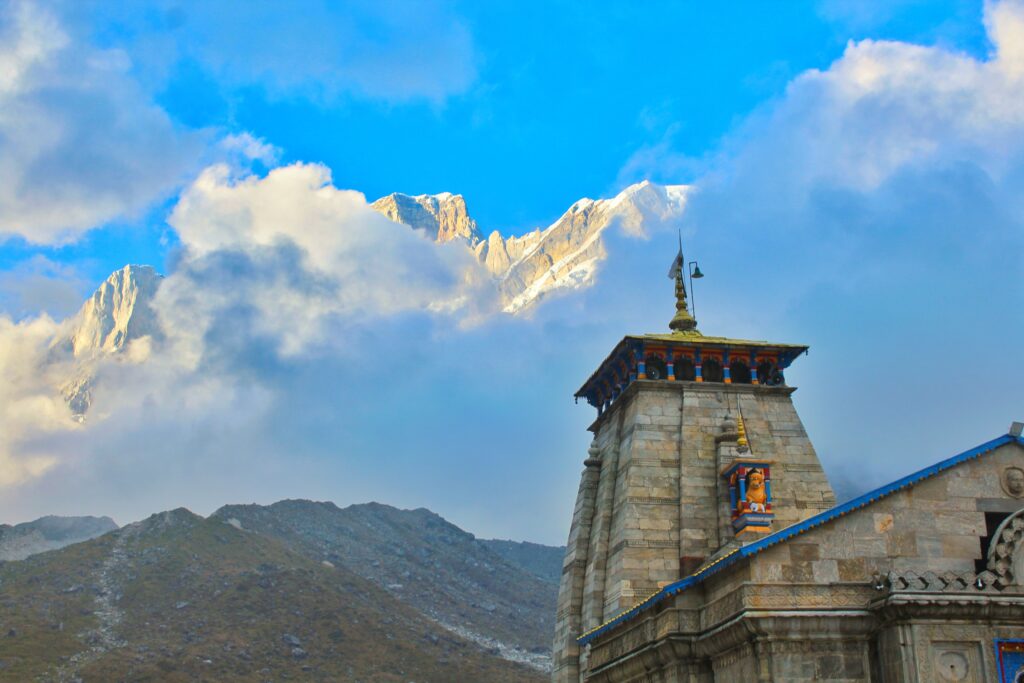Table of Contents
Introduction

Kedarnath is a holy Hindu village found in Uttarakhand’s Rudraprayag district. One of the Char Dhams in the Himalayas is located close to the Mandakini River’s head at an astonishing elevation of 3584 meters above sea level. In this space, we will have a look at the Kedarnath tour guide that would help you when you plan for the tour.
Thousands of visitors and pilgrims visit the Kedarnath temple each year, which is surrounded by the spectacular snow-capped Garhwal Himalayan peaks. However, even among treks, the Kedarnath trip is breathtakingly gorgeous and varied.

The name Kedarnath, which translates to “the Lord of the field,” comes from the fact that here is where the “crop of emancipation” grows. Even if it’s unclear when or who built the temple! Around the seventh or eighth century, Kedarnath is mentioned for the first time. Adi Shankara is said to have passed away close to the sanctuary.
Location
Kedarnath, the most distant of the Chota Char Dham locations, is situated in the Rudraprayag area. Kedarnath, which is surrounded by snow-capped peaks, is located close to the Chorabari Glacier, which is the Mandakini river’s source. The Kedarnath mountain (6,940 mts) and the Kedar Dome are particularly notable (6,831 mts). The settlement is situated 223 kilometers away from Rishikesh and is constructed on a desolate riverbank.
Unfortunately, in 2013 flash floods brought on by monsoon rainfall in Uttarakhand severely damaged the town. The temple brilliantly withstood the severe disasters!
Weather
Kedarnath has chilly summers, which are consistent with the Himalayan climate, and very cold winters. All types of sightseeing, temple visits, and visiting local sites are best done during the summer. In the summer, the typical temperature is approximately 17 degrees.
The region has often seen very heavy rains during the monsoon season, especially in 2013. 12 degrees are typical during the monsoon. Winters are harsh, complicated, and unbearable. From November to April, Lord Kedarnath palki is moved to its winter residence close to Guptakashi-Ukhimath. The weather is usually bad at this time of year!
How to Reach
By Air
The nearest airport is Jolly Grant Airport in Dehradun, which is about 238 kilometers away. With frequent flights, the airport is well-linked to Delhi. From the airport, taxis are readily accessible to Gaurikund.
By Rail
Rishikesh, which is located 216 kilometers before Kedarnath on NH58, is the railroad station that is closest to the holy site. Moreover, Rishikesh and Gaurikund are well-linked by motorable highways. To get to Gaurikund, taxis, and buses are readily accessible.
By Road
The last motorable location before arriving in Kedarnath is Gaurikund. You will then hike for about 16 kilometers. Major North Indian cities are linked to Gaurikund. From Haridwar, Rishikesh, and Rudraprayag to Sonprayag, the final location where private cars are permitted, buses and shared taxis are available.
At ISBT, Kashmiri Gate, buses are accessible to Rishikesh and Shringar. The government provides a shared taxi service from Sonprayag that will drop you off at Gaurikund for a charge.
By Helicopter
If you don’t like hiking, you could even take a helicopter trip (but we highly advise hiking!). The services are offered from a variety of helipads, including Guptkashi, Sersi, Phata, and others.
Kedarnath Tour Guide: Places to Visit
Kedarnath Temple
One of Lord Shiva’s twelve Jyotirlingas is the Kedarnath Temple, which is encircled by the powerful Garhwal Mountains. The most significant of the Panch Kedars and one of the 275 temples that make up Paadal Petra Sthalams, the most potent Shiva temple in the world, is Kedarnath Temple, which is dedicated to Lord Shiva.

You will lose all sense of time here, with fresh air associated with the highlands and breathtaking vistas that you have to earn! This location has been a center of worship for many years, and the area exudes a positive, hopeful, and forward-looking attitude.
You will be welcomed by a tiny hall that is filled with pictures of Parvati and the Pandavas within the temple. The hall is embellished with sculptures of many different gods, including Krishna, the Pandavas, Draupadi, and Virbhadra. Within the shrine, a conical rock known as the Sadashiva is revered (forever Shiv).
The temple is very stunning against the background of the Himalayas because it is constructed of grey stones that are connected using iron clamps.
Gandhi Sarovar
Gandhi Sarovar, also called Chorabari Tal, is a little lake that is immaculately clean. This is the case due to its location near the glacier’s mouth, Chorabari Bamak. Gandhi Sarovar is located at an incredible elevation of 3,900 meters above sea level at the base of the Kedarnath and Kirthi Stambh mountains. The lake is reached after a further 4 KM of hiking from Kedarnath Temple.
Kalimath
Upon the Saraswati River’s banks sits the holy city of Kalimath. One of India’s 108 Shakti Peeths, Kalimath is situated at an elevation of 1800 meters. Kalimath is surrounded by nature and offers a serene and heavenly setting. At Kalimath stands the Goddess Kali Temple. Legend has it that the Kali Goddess left this location here after murdering Raktbeej.
Bhairav Temple
On the eastern peak of the Himalayan Himalayas of Uttarakhand, Bhairavnath Temple, also known as Bhairon Baba Mandir, is located south of Kedarnath Temple. The temple is devoted to Lord Shiva’s furious avatar known as Bhairav, who is known for wreaking havoc and causing damage. The temple is a nice stop on your way to Kedarnath and provides some amazing Himalayan views!
Gaurikund Temple
Hinduism’s basic ideas are said to have been established and brought together by the scholar Adi Shankaracharya. At the age of 32, he made the decision to find moksha in Kedarnath and blended with the surrounding landscape. Just behind the temple is where you’ll find the samadhi.
Shankaracharya Samadhi
Hinduism’s basic ideas are said to have been established and brought together by the scholar Adi Shankaracharya. At the age of 32, he made the decision to find moksha in Kedarnath and blended with the surrounding landscape. Just behind the temple is where you’ll find the samadhi.
Vasuki Tal Lake
At Kedarnath Dham, at an astonishing 14,200 feet above sea level, lies the high glacial lake known as Vasuki Tal. Around the tranquil lake, Brahma Kamal and other Himalayan flowers are in bloom, creating some breathtaking sights.
In a perfect world, I would advise you to finish the journey during the day and stay the night in Kedarnath! The trip is 8 kilometers from the Kedarnath temple; the first 3 to 4 kilometers are simple before the ascent starts. Only 900 meters descend from Vasuki summit to the cold Vasuki Tal.
Guptkashi
47 kilometers separate from Guptkashi from Kedarnath, the sacred site of Lord Shiva. It is situated at an altitude of 1,319 meters above sea level on a hill on the western side of the Mandakini river valley along the Kedarnath path.
Due to the presence of historic temples like the Ardhnareshwar and Vishwanath temples, Guptkashi is a significant town in Uttarakhand from a religious standpoint. Where the Ganga and Yamuna rivers converge, Manikarnika Kund is a beloved destination.
Food and Stay
Sadly, there are just roadside dhabas and food stands to choose from for excellent meals in this area. The majority of the food on offer is north Indian food. Of course, it should not be surprising that alcohol and non-vegetarian meals are not offered or are forbidden considering the extremely venerated status that Kedarnath enjoys in Hinduism.
A sizable government-run tent colony, as well as cottages and apartments, are all managed by GMVN. More than a thousand pilgrims and guests might stay in them. In addition, Dharamshala, hotels, and guest homes are available.
Because many people have begun traveling by helicopter, possible places to stay include Phata, Rampur, Gaurikund, Sitapur, etc.

Kedarnath Tour Guide: Things to Note
- According to the Uttarakhand government’s instructions, it is mandatory for all visitors to complete a biometric registration. Also, the facility is accessible online. You may also carry out the same action at Sonprayag.
- It is simple to locate mules and porters to help you on your trip. Keep in mind to verify the advertised pricing in order to avoid paying more.
Also, if you are employing porters or mules, verify their legal IDs. - Avoiding mountainous terrain during the rainy season is usually a good idea. Particularly in light of the catastrophe in 2013 and how severely Kedarnath was damaged. Consult with officials and local authorities if you want to go there during the rainy season.
- On the grounds of the temple, photography is prohibited. Be aware of this and follow the guidelines set out by the temple’s administrators.
- Depending on your health, the 16 Kilometer walk should take you 6 hours to complete.
- You should try to start your trek early in the morning to escape the hot afternoon sun.
- You should also remember to have a filling yet light breakfast.
- Finally, you should keep hydrated. Just keep in mind to bring your own water bottles.
Conclusion
Hope this Kedarnath tour guide helps. Visit Kedarnath if you want to rejuvenate, connect with nature and the Gods, and experience some adventure on your next vacation. You’ll be transported to a period of simplicity and sincerity by this location. You’ll fall in love with the charming way of life in the hills and with the majesty of pure faith.

Even after going through this Kedarnath tour guide, you may have queries. Please leave a comment below if you have any questions about this lovely paradise, and our team would be pleased to respond.
Travel safely!
